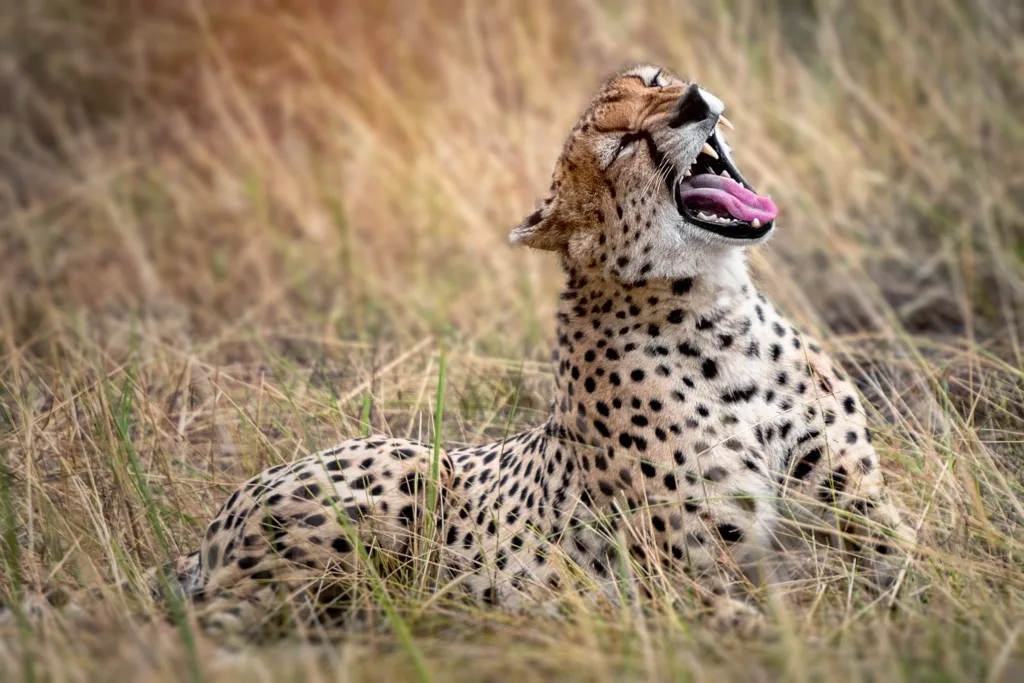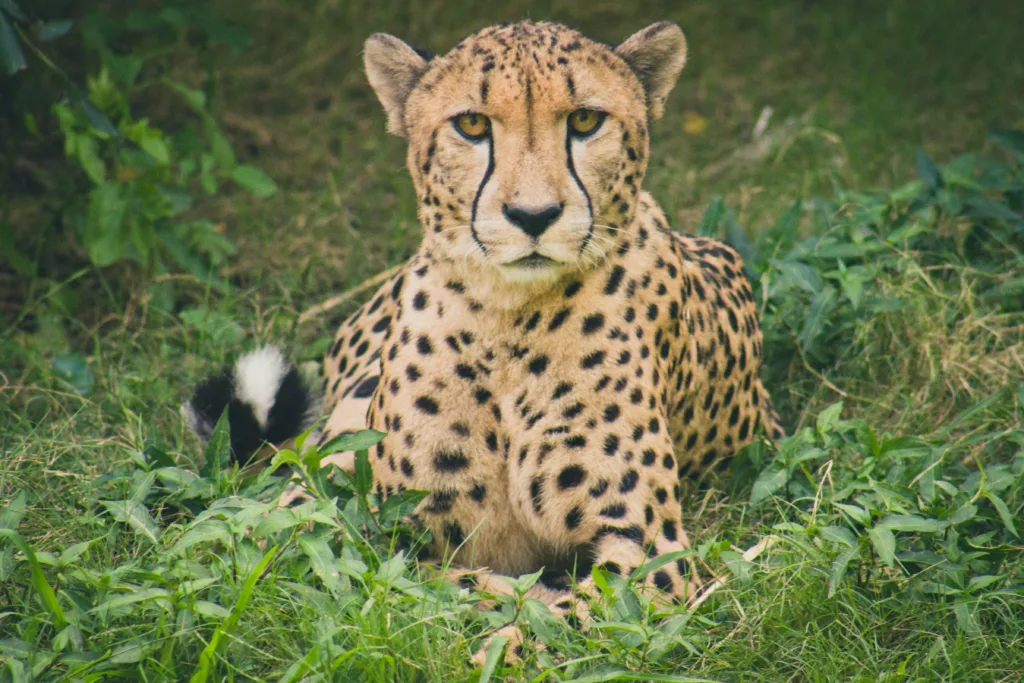The cheetah, known for its incredible speed and agility, is often revered as one of the most majestic creatures in the animal kingdom. But did you know that cheetahs also possess a unique vocal ability? While they may not have the powerful roar of their larger feline relatives, cheetahs are capable of producing a variety of sounds, including meows, purrs, and chirps.
Unlike lions or tigers, cheetahs do not possess the anatomical structure necessary for roaring. The bones in their voice box are fixed, with divided vocal cords that vibrate both during inhalation and exhalation. This fixed structure prevents cheetahs from producing the deep, resonating sound associated with a roar. However, it does allow them to create other vocalizations that are equally fascinating.
One of the most distinctive sounds made by cheetahs is their meow. Similar to the meow of a domestic housecat, the cheetah’s meow is a high-pitched vocalization that serves various purposes. Females in estrus, or heat, often use meowing to attract potential mates. This call is a way for them to communicate their availability and readiness to reproduce.
In addition to meowing, cheetahs also possess the ability to purr. Purring is a common sound associated with contentment and relaxation in many domestic cats. Cheetahs, despite their wild nature, have this same capability. The purring sound is created by the vibration of the vocal cords caused by the passage of air through the larynx. It is believed that cheetahs purr as a means of self-soothing and relaxation.
Another intriguing vocalization made by cheetahs is their chirp. This unique sound has multiple meanings and is used in different contexts. Similar to meowing, females in estrus may chirp to attract potential mates. It is also used as a distress call by both male and female cheetahs. When separated from their coalition members, cheetahs may chirp to locate and reunite with their companions. This vocalization is also observed between cheetah mothers and their cubs, serving as a way to communicate and maintain contact.
The ability to produce these various sounds is attributed to a small bone called the epihyal bone, located near the cheetah’s larynx. This bone is responsible for allowing cats, including cheetahs, to purr. Interestingly, big cats such as lions and tigers lack this bone and instead rely on ligaments to produce their vocalizations.
Despite their remarkable vocal abilities, cheetahs face numerous challenges in the wild. They are considered the most vulnerable of all the world’s big cats, primarily due to habitat loss, poaching, and human-wildlife conflict. Conservation efforts are crucial to ensure the survival of these magnificent creatures and to protect their unique vocal repertoire.
The cheetah’s vocalizations may not include a mighty roar like its larger feline relatives, but they are no less fascinating. From meows to purrs to chirps, these sounds serve various purposes in the cheetah’s communication repertoire. Understanding and appreciating these vocalizations can provide us with a deeper insight into the lives of these incredible creatures and the importance of their conservation.
Do Cheetahs Meow Or Roar?
Cheetahs possess the ability to meow, unlike their roaring counterparts. In addition to meowing, cheetahs also have the ability to purr. This distinctive vocalization can be likened to the sounds made by domestic housecats. The unique structure of the cheetah’s voice box, known as the larynx, plays a significant role in producing these vocalizations.
The larynx of a cheetah consists of a fixed structure, with vocal cords that are divided. This division allows for vibrations to occur during both inhalation and exhalation, resulting in the production of various sounds. While most big cats, such as lions and tigers, are known for their powerful roars, cheetahs lack the necessary vocal anatomy to produce such intense vocalizations.
The meowing sound produced by cheetahs is notably different from their roaring relatives. Meowing is a soft and gentle vocalization, often used by cheetahs for communication purposes. It is a more subtle and melodic sound compared to the deep and thunderous roars of other big cats. The ability to meow and purr sets cheetahs apart in the feline world.
Cheetahs possess the ability to meow, which is a unique vocalization among big cats. Their voice box structure, comprising a fixed larynx with divided vocal cords, enables them to produce these meowing sounds. This sets them apart from other big cats that are known for their powerful roars.

Does A Cheetah Roar?
Cheetahs do not roar. Unlike other big cats such as lions, tigers, and leopards, cheetahs lack the ability to produce a roar. Instead, they communicate through a variety of different vocalizations, one of which is a purr. The purr of a cheetah is a low, rumbling sound that they use to communicate with each other, especially during social interactions or when they are content and relaxed.
It is important to note that while cheetahs cannot roar, they still belong to the broader category of “big cats” that includes other species such as snow leopards and cougars. Conservation groups often use this wider definition when discussing the conservation efforts and protection of big cats.
The vulnerability of cheetahs is a significant concern for conservationists. Despite their incredible speed and agility, cheetahs face numerous threats in the wild, including habitat loss, poaching, and human-wildlife conflict. These factors have led to a decline in their population, making them the most vulnerable of all the world’s big cat species.
Cheetahs do not roar but communicate through purring and other vocalizations. They are part of the broader category of big cats, which includes other species like snow leopards and cougars. Cheetahs are highly vulnerable due to various threats, and their conservation is of utmost importance to ensure their survival in the wild.
Why Do Cheetahs Chirp?
Cheetahs chirp for various reasons. Firstly, female cheetahs chirp to attract potential mates when they are in estrus. This chirping behavior serves as a signal to males that they are ready to reproduce.
Additionally, both male and female cheetahs chirp when they are distressed or in distressing situations. This vocalization is a way for them to communicate their discomfort, fear, or anxiety. It can occur in response to threats, aggression, or any other situation that causes stress.
Male cheetahs also chirp when they are separated from their coalition members. Coalitions are formed by groups of related males, usually siblings, who join forces for increased hunting success and territorial defense. When a male cheetah is separated from his coalition, he may chirp as a form of communication to locate and reunite with his companions.
Similarly, mother cheetahs and their cubs may also chirp to communicate with each other. This vocalization serves as a way for the mother to locate her cubs or for the cubs to find their mother when they are separated. It helps in maintaining contact and ensuring the safety and well-being of the family unit.
Cheetahs chirp for various reasons, including attracting mates, expressing distress or anxiety, locating coalition members, and communicating within the family unit. This vocalization plays an important role in their social interactions and survival strategies.
Where Is The Cheetah Sound?
The sound produced by a cheetah can be attributed to various parts of its body. The primary sources of sound in a cheetah are its vocal cords and the air passing through them. The vocal cords are located in the larynx, commonly known as the voice box, which is situated in the throat region of the cheetah.
When a cheetah vocalizes, such as when it purrs or makes other sounds, the air from its lungs passes through the vocal cords. The vocal cords vibrate, creating sound waves that travel through the cheetah’s throat and mouth, eventually reaching our ears.
Additionally, cheetahs possess a specialized bone called the epihyal bone, which is located near the larynx. This bone plays a crucial role in producing the purring sound. When a cheetah purrs, the epihyal bone vibrates, amplifying the sound produced by the vocal cords.
It is important to note that cheetahs also possess other means of communication, such as hissing, growling, and chirping. These sounds are also produced in the same region, involving the vocal cords, larynx, and mouth.
The sound produced by a cheetah originates from its vocal cords, located in the larynx, and is further amplified by the vibrations of the epihyal bone when purring.

Conclusion
Cheetahs are unique among the big cat family in their vocalizations. While they can’t roar like their cousins, they have the ability to meow, purr, and chirp. This is due to the structure of their voice box, which differs from other big cats. The epihyal bone near their larynx allows cheetahs to produce the soothing purring sound that we often associate with domestic cats. Additionally, their chirping serves various purposes, from attracting mates to expressing distress or reuniting with their coalition members. It is fascinating to see how the absence of a small bone can create such a distinct vocal range in cheetahs, making them even more unique and intriguing creatures in the animal kingdom.
